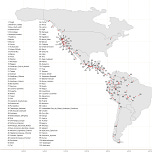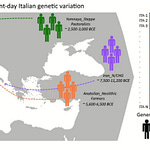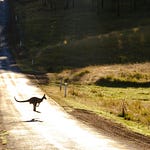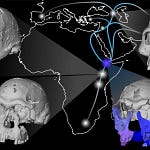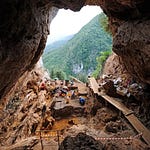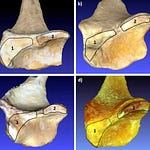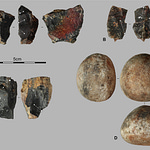By the time Europeans arrived in the Americas, thousands of distinct Indigenous languages had already shaped the way people described landscapes, kinship, time, and the cosmos. These languages, many of which still survive today, are more than means of communication—they are archaeological strata encoded in speech. A new study in Scientific Reports1 argues that their grammar preserves a faint but measurable imprint of the first humans to populate the continent.
Language as a map of migration
Michael Urban and Mario G. Naranjo have identified a gradient in grammatical complexity across the Western Hemisphere that aligns with the likely direction of prehistoric human expansion. The study, which analyzed over 400 Indigenous languages, reveals that certain structural features in grammar—specifically the number of syntactic categories—decrease systematically from north to south. That is, the languages spoken farther south tend to have simpler syntactic architecture than those to the north.
This pattern, the researchers argue, reflects an ancient demographic expansion—a gradual movement of people from Beringia into the Americas that unfolded over thousands of years.
“If people expanded through the Americas in a stepwise fashion, each new group carrying only part of the linguistic complexity of its ancestors, the result would be a continent-wide gradient of grammatical structure,” the authors write.
This gradient doesn't just trace the familiar corridor from Alaska to Tierra del Fuego. It mirrors a broader pattern known from paleogenomics and ecology: complexity tends to diminish with distance from the point of origin, much like species diversity drops the farther one moves from the equator. In this case, however, the origin is likely in the north.
Linguistic bottlenecks and demographic echoes
The study builds on a long-standing hypothesis in historical linguistics and evolutionary anthropology—that migration events, especially those involving small founder populations, reduce linguistic diversity. Similar arguments have been made in phonology, where the number of distinct speech sounds tends to be higher near Africa, declining with distance across Eurasia and into the Americas.
But Urban and Naranjo focus not on sounds, but on syntax. They counted the number of syntactic categories (such as noun phrases, verb phrases, etc.) coded into the grammar of each language. The result was striking: languages in the Arctic and Subarctic regions averaged significantly more categories than those in the Amazon and Andes.
To ensure this wasn’t an artifact of sampling or contact with European languages, the team excluded creoles, mixed languages, and known colonial effects. They also controlled for genealogical relationships between languages to prevent redundancy. What remained was a clear, statistically robust trend.
“It suggests that grammatical complexity, like genetic variation, can reflect the demographic history of a population,” the study concludes.
A linguistic fossil record
Linguistic diversity in the Americas is exceptionally high, and its origins are hotly debated. While some scholars emphasize deep time depth, with separate migrations explaining the divergence, others argue for rapid diversification after a single major migration event.
The new findings support the latter view. The authors suggest that much of the grammatical variation we see today could have emerged within the past 15,000 years—after the initial colonization wave. In that sense, syntax acts like a fossil record, a nonmaterial archive of how people adapted their languages as they moved into new environments and lost contact with parent populations.
This doesn’t mean languages become inherently simpler over time, or that southern languages are in any way deficient. Rather, simplification is a byproduct of isolation and drift. In small, scattered groups, some parts of language—like complex case systems or agreement rules—may be lost because they’re no longer needed or are too costly to maintain.
“Languages evolve in response to the social and ecological conditions of their speakers,” says the study. “And migration reshapes both.”
Broader implications for archaeology and evolution
The gradient model has wide implications. For archaeologists, it offers an independent line of evidence for reconstructing prehistoric movements, especially in regions with sparse material remains. For anthropologists, it challenges assumptions about linguistic universals by highlighting how social dynamics influence grammar.
And for evolutionary biologists, it’s a reminder that language—like DNA—retains traces of deep ancestry, subject to the same forces of drift, selection, and dispersal.
Future research may extend this model to other regions, such as Southeast Asia and Oceania, or test whether similar gradients exist in cultural practices like myth, kinship, or cosmology. For now, the voices of Indigenous languages continue to whisper across the landscape, tracing invisible pathways left by the continent’s first explorers.
Related Research
Hay, J., & Bauer, L. (2007). Phoneme inventory size and population size. Language, 83(2), 388–400. https://doi.org/10.1353/lan.2007.0071
Lupyan, G., & Dale, R. (2010). Language structure is partly determined by social structure. PLoS ONE, 5(1), e8559. https://doi.org/10.1371/journal.pone.0008559
Atkinson, Q. D. (2011). Phonemic diversity supports a serial founder effect model of language expansion from Africa. Science, 332(6027), 346–349. https://doi.org/10.1126/science.1199295
Bowern, C. (2010). Historical linguistics in Australia: Trees, networks and their implications. Philosophical Transactions of the Royal Society B, 365(1559), 3845–3854. https://doi.org/10.1098/rstb.2010.0025
Reich, D. (2018). Who We Are and How We Got Here: Ancient DNA and the New Science of the Human Past. Pantheon.
Urban, M., & Naranjo, M. G. (2025). Gradient in grammatical structure of indigenous languages reflects pathway of human expansion in the Americas. Scientific Reports, 15(1), 14365. https://doi.org/10.1038/s41598-025-86265-8

